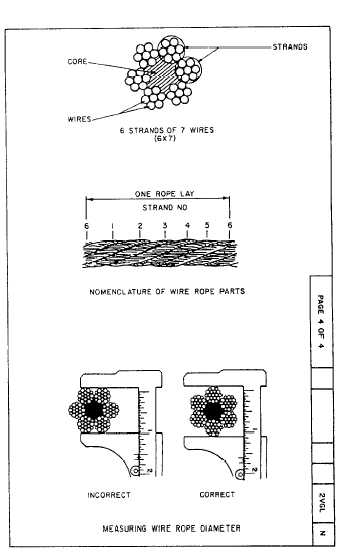| |
If wire rope is being run off one reel to a winch drum
or another reel, run it from top to top or from bottom to
bottom, as shown in figure 3-27.
Make up short lengths of wire rope in coils and stop
off tightly for stowage. When uncoiling wire rope, stand
the coil on edge and roll along the deck, uncoiling as you
go, as in figure 3-28.
Whenever possible, drums, sheaves, and blocks
used with wire rope should be placed so as to avoid
reverse or S-shaped bends. Reverse bends cause an
unnecessary amount of shifting of the individual wire
strands, increasing wear and fatigue. Where a reverse
bend is needed, the blocks and drums effecting the
reversal should be of larger diameter than ordinarily
used and should be spaced as far apart as possible.
If a wire rope becomes kinked, never try to pull it
out by putting a strain on either part. As soon as a kink
is noticed, uncross the ends by pushing them apart. See
step 2 in figure 3-29. Performing these steps reverses
the process that started the kink. Now turn the bent
portion over and place it on your knee or some firm
object and push downward until the kink straightens out
somewhat. Then lay it on a flat surface and pound it
smooth with a wooden mallet.
If a heavy strain is put on a wire rope with a kink in
it, the rope no longer can be trusted. Cut out the kinked
part and splice the ends together.
Frequently, abrasion or reverse or sharp bends cause
individual wires to break and bend back. These broken
wires are known as fishhooks.
Wire rope should be inspected frequently, checking
for fishhooks, kinks, and worn and corroded spots.
Worn spots show up as shiny flattened surfaces. To
determine the wear, you must know (1) the original
diameter of the wire rope, (2) the present diameter of
the wire rope at the worn place, and (3) the diameter of
a single wire in one of the strands of the wire rope. The
original diameter of the rope is shown in the ship's
allowance list or in the first lieutenant's records. The
actual diameter of the rope is found by measuring it with
a micrometer or vernier caliper, as shown in figure 3-30.
One or more of the following conditions is
sufficient reason for questioning the rope's safety and
considering replacement:
1. The normal rope diameter is reduced by more
than the amount shown in table 3-2 for the applicable
size rope. See figure 3-30 for the correct method of
measuring diameter.
2. Six broken wires in one rope lay length, or three
broken wires in one strand lay length. See figure 3-30
for definition of a lay length.
Figure 3-30.–Measuring wire-rope diameter.
Table 3-2.–Wire-Rope Allowable Diameter Reduction
Maximum Allowable
Nominal Diameter
Rope Diameter (inches)
Reduction (inches)
5/16 and smaller
1/64
3/8 to 1/2
1/32
9/16 to 3/4
3/64
7/8 to 1 1/8
1/16
1 1/4 to 1 1/2
3/32
19/16 to 2
1/8
2 1/8 to 2 1/2
5/32
3-21
|

